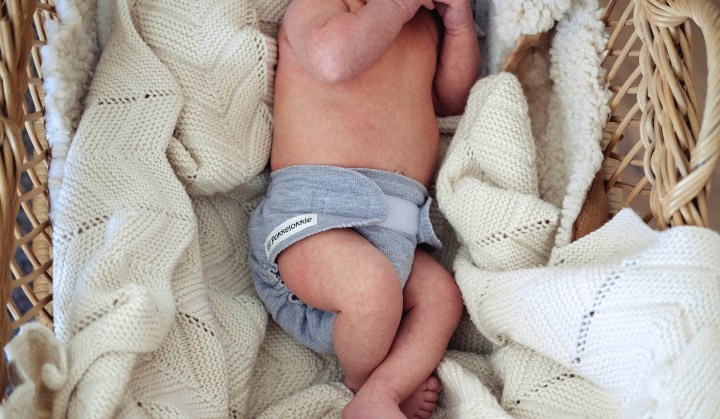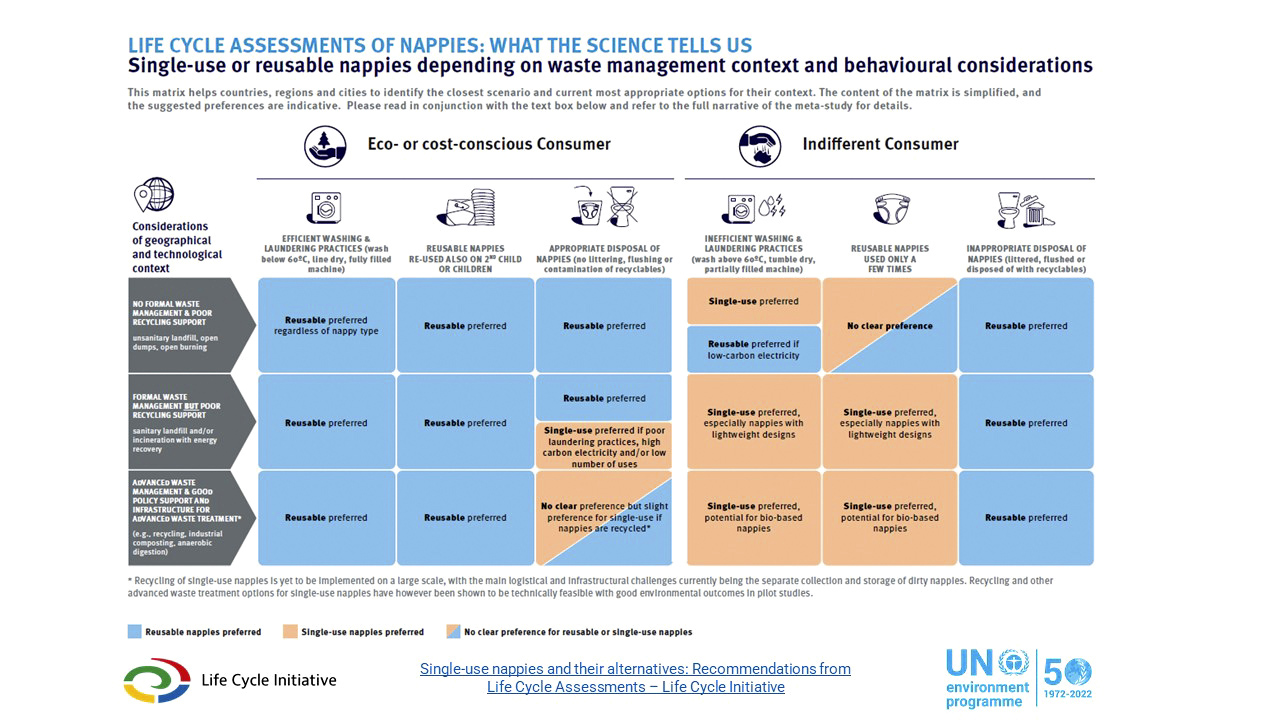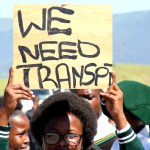STINKY STORY
Nappies and pads fill up our landfills — action is needed by producers and consumers (Part One)

The average child will use more than 4,000 nappies between birth and potty training, all of which will end up in South Africa’s landfills. The evidence is clear — we need a shift to reusables.
In the past, when a company sold a product that came in packaging, it was up to the consumer to decide what to do with that packaging, and with the product when it was no longer needed. Companies didn’t have to take responsibility once you bought the product, and waste was a consumer and municipality problem.
Take eggs in a box, for example. A consumer would buy them from a shop, eat the eggs, toss the shells either into their rubbish or their compost, and either recycle the box or dispose of it in their waste. This waste would (hopefully) be collected by a municipality and sent to a landfill where it would begin the process of decomposing. An egg box, usually made of cardboard, might decompose quite quickly. But other packaging and products take far longer, sitting in landfills for many thousands of years.
This usual way of doing things changed dramatically in November 2020, when the Department of Forestry, Fisheries, and the Environment (DFFE) put in place regulations regarding Extended Producer Responsibility in terms of the National Environmental Management Waste Act. The regulations were amended in May this year.
The new regulations meant that companies had to take responsibility for the waste they were producing and so aimed to reduce the waste created in food and consumer goods packaging by ensuring that end-of-life products were managed by the organisations that produced them. In simple terms — if you, your brand, company, or shop produced, used, or imported packaging that was used on the goods you produced, sold, or imported, then the regulations made you liable for that packaging waste when it was no longer needed.
To return to our egg in the box, if your company sold an egg in a box, you were no longer just responsible for health and safety issues associated with the egg, but also for the management of the post-consumer packaging waste (the box) including the design, collection, sorting, and recycling of that box. To do this you had to join an existing scheme managed by a Producer Responsibility Organisation (PRO), form your own PRO, or submit an independent EPR scheme to the DFFE for your packaging. Companies were supposed to comply with these regulations by 5 November 2021.
These EPR regulations have already had a huge impact on the ways that retailers, producers, and importers have used packaging around their products, and have the potential to increase recycling and reduce waste. But unfortunately, they only applied to certain waste streams and sectors — electrical and electronic equipment, lighting, paper, packaging, and some single-use products. They didn’t apply to a very important waste stream — absorbent healthcare products — known to you and me as nappies (for infants and adults), sanitary pads, and tampons.
According to recent research from the Life Cycle Initiative and the United Nations Environment Programme (Unep) “single-use nappies are one of the biggest contributors to plastic waste globally” and because they’re made from multiple materials, they have huge environmental impacts across their end of life cycle. Since EPR regulations don’t yet apply to producers of these products, the burden of their disposal falls to municipalities in South Africa, and they are often sent to landfills.
“I remember seeing a statistic that it takes 500 years for a disposable nappy to disintegrate,” says Catherine Dowie, founder of South Africa’s Cloth Nappies User Association (Sacnu). Disintegration doesn’t mean biodegradation. “Someone said to me, if Shakespeare had used disposables, his nappies would still be in the landfill. As a parent, when you bring children into the world you know that your environmental footprint is becoming larger and so we have to make choices as to what impact we’re going to make. [At Sacnu] we’re not anti-disposables, we understand that there is a time when you might have to use them, or you might use both, but it’s about making the choice about how many you’re willing to put into landfill.”
Each year almost a million new babies are born in South Africa, each of whom will require some form of nappies to get by. By Sacnu’s estimates, the average child uses around 4.6 disposable nappies per day, for around 30 months, with each nappy weighing around 230g. A single child will therefore use around 4,140 disposable nappies and generate almost a ton of waste by the time they are potty trained. Sacnu estimates that roughly 2.408 tonnes of disposable nappy waste are generated per day in South Africa. Times that by a million new babies, every single year, and the figures are staggering. In contrast, Sacnu estimates that a child using cloth nappies will generate just 2.2kg of nappy waste from birth to potty training (mostly from disposable liners and wipes).
But comparing the environmental impact of disposable nappies, and pads, to reusables is not a simple process, explains Philippa Notten of the Life Cycle Initiative, which is why a life cycle assessment is a very helpful tool.
“A life cycle assessment (LCA) looks at the whole life cycle of the product. It’s going all the way from the materials, and importantly including the use of the product and the disposal of the product. Some products are strong in one area, but weak in another,” says Notten.
Reusable nappies and pads, for example, require water and energy for washing and drying (if using a tumble dryer). Some materials are heavily water-intensive to produce, having their own environmental impact. At the same time, innovations in single-use nappies make them lighter, and internationally recycling solutions for these products are emerging.
Context matters too — when you’re thinking about environmental impact you have to think about the energy sources used to power the washing machine that washes your nappy (in South Africa, coal power), whether your washing machine is full, etc. In addition, in the disposable and reusable absorbent healthcare products sector, “the variation between producers is often higher than the variation between materials”, explains Notten, making a simple comparison more complex. Thankfully, the Life Cycle Initiative and Unep research provides a useful overview of what we should be thinking about when we’re comparing, as shown in the matrix below.

(Supplied: Life Cycle Initiative and UNEP)
Their research evaluated the findings of seven life-cycle assessments conducted in different places around the world and found that “when comparing single-use nappies with reusable nappies, reusable options when washed so as to minimise water use (eg., in a fully loaded, modern washing machine) and in an energy efficient manner have lower environmental impacts”. Their similar study on single-use menstrual products and their alternatives found that reusable menstrual products (including cloth pads and menstrual cups) have a substantially lower environmental impact than commonly available single-use options.
The research shows that another reason reusables tend to come out on top is the fact that consumers have the ability to choose how they launder their nappies, reducing impact by washing full loads, choosing water- and energy-efficient washing machines, washing at temperatures below 60 degrees, line-drying their nappies, and reusing them as many times as they can (either with a second child or selling them on to another user). Dowie, for example, “used the same reusable nappies on baby one, two and three, and since then I’ve passed them on. So, they can last up to five, six babies, and that is an enormous saving”, both for the environment and financially.
In contrast, because there are no local recycling solutions for disposable nappies or pads in South Africa, it’s almost guaranteed that they will end up in a landfill if they are disposed of properly by consumers, meaning that a consumer has no other option but to contribute to landfill waste. In 2019, the government of the Vanuatu archipelago announced a ban on disposable nappies after research there showed that organic waste and disposable nappies made up three quarters of the total weight of waste produced.
Locally, in 2018, the Green Building Council estimated that more than 3.5 billion soiled nappies are disposed of to landfill every single year. In the City of Cape Town alone, Green Cape’s Market 2021 Intelligence Report indicates that nappies make up 6.75% of all of the city’s waste, with an estimated 72,968 tonnes going to landfill in 2020. Nappy waste, as well as waste generated by sanitary pads and tampons, contributes significantly to our landfills.
Unfortunately, none of the LCAs in the study were able to look at poorly disposed of single use nappies –ie, those that are dumped in rivers, roadsides, and illegal and informal waste dumps. However, it’s important that any solutions aimed at shifting from disposables to reusables considers the socioeconomic context of the users of nappies, the barriers to changing from disposables to reusables, and makes sure that there are effective waste removal services in all communities.
Where the upfront cost of reusables is a prohibiting factor, incentives might help to shift behaviour away from disposables. In the UK, for example, some local councils offer a reusable nappy incentive scheme to encourage the use of reusables over disposables by providing cash back to consumers, offering free nappy starter packs, or offering cloth nappy trials to parents.
In South Africa, changing the regulatory environment by introducing regulations like EPR around absorbent hygiene products could be a game changer by encouraging producers of disposable nappies to consider alternative and more environmentally friendly materials to produce disposable nappies, or to develop recycling solutions for their products. It’s clear that more circular economy solutions are needed.
The Unep and Life Cycle Initiative research suggested that there was a need for policymakers to take a more proactive stance.
“Consumer awareness of the environmental impact of single-use nappies is growing and the risks for producers and governments in not acting to minimise these is increasing too. Policy makers need to act decisively, drawing on best practice to reduce plastic pollution and minimise environmental impacts while also protecting the health and safety of their citizens.”
Luckily in South Africa, several local brands are taking up the mantle of making reusables more accessible and affordable for all of us. See part 2 of this piece. DM/MC

















 Become an Insider
Become an Insider
Comments - Please login in order to comment.